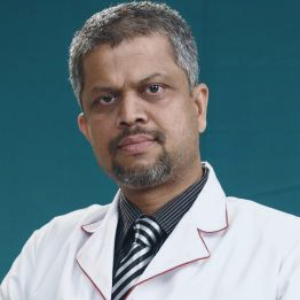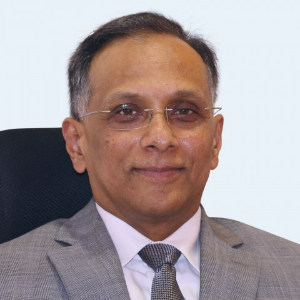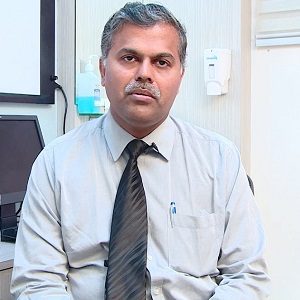Best Stereotactic Radiosurgery Doctors in india
- Neurosurgeon & Spine Surgeon, Mumbai, India
- Over 20 years’ experience
Profile Highlights:
- Dr. Rahul Modgi is a highly established neuro and spine surgeon in Mumbai specializing in all types of brain and spine surgeries.
- Dr. Rahul Modgi’s name has been recorded in the Limca Book of Records in 2014 when he removed the heaviest iron rod from the brain of a 17-year-old patient. He has also performed various other risky surgeries for which he has greatly appreciated.
- Neurosurgeon, Bengaluru, India
- Over 30 years’ experience
Profile Highlights:
- Dr. Rajakumar V Deshpande is a renowned Neurosurgeon in Bengaluru. He performed the first pedicle screw fixation surgery for a spine injury in Bangalore.
- Dr. D V Rajakumar specializes in endoscopic neurosurgeries and has performed some of the most complex brain and spine surgeries through the endoscopic approach. His other areas of interest include minimally invasive neuro surgeries, management of cerebrovascular diseases, and brain tumor surgeries.
- Neurosurgeon, Mumbai, India
- Over 20 years’ experience
Profile Highlights:
- Dr. Suresh Sankhla is an accomplished Neurosurgeon in Mumbai specializing in endoscopic neurosurgery and onco-neurosurgery.
- Dr. Sankhla acquired his training in neurosurgery under the guidance of the best trainers from well-known medical institutes and hospitals in Ireland, UK, USA as well as India.
- He has an equal interest in research and has published more than 100 articles, papers, and abstracts in renowned national and international peer-reviewed journals.
- Radiation Oncologist, Gurugram, India
- Over 20 years’ experience
Profile Highlights:
- Dr. Indu Bansal Agarwal is the Director and Senior Consultant in the Department of Radiation Oncology at Narayana Superspeciality Hospital, Gurugram.
- Dr. Indu Bansal Agarwal is extremely skilled in high-end techniques such as SRS, FSRS, IMRT, intraluminal, and interstitial brachytherapy. Her special areas of interest are Pediatric tumors, Central Nervous System Tumors, and Breast, Head and Neck Cancers.
- Dr. Indu Agarwal has co-authored chapters of several books and also has numerous publications to her credit in National and International Journals.
- Neurosurgeon, Chennai, India
- Over 25 years’ experience
Profile Highlights:
- Dr. M. Balamurugan is a well-known neurosurgeon in India with 25 years of experience.
- Dr. Balamurugan assists in managing Carotid Body Tumor Embolization, Brain Arteriovenous Fistula Embolization, Nerve and Muscle Disorders, Spinal and Cerebral Tumor Embolization, etc.
- Dr. Balamurugan is a life member of various prestigious associations and institutions.
- He also authored research studies or papers and articles for several publications.
- Neurosurgeon, Chennai, India
- Over 22 years’ experience
Profile Highlights:
- Dr. Srinivasan Paramasivam is a well-known Neurosurgeon in India having an overall experience of 22 years.
- He is associated with Apollo Hospital, Chennai as a senior consultant – neurosurgeon following his assignments abroad.
- Dr. Paramasivam earned a fellowship in Endovascular Neurosurgery from New York. He has 17 years of specialized experience in Neuro Interventional Surgery, Cerebral Angioplasty, Brain Tumor Surgery, Surgical Clipping, etc.
- Radiation Oncologist, Chennai, India
- Over 30 years’ experience
Profile Highlights:
- Dr. Sanjay Chandrasekar serves as a Radiation Oncology consultant at Apollo Hospital of Chennai. His 30+ years-long journey in this field has brought him a lot of appreciation and recognition.
- He diagnoses cancer and provides treatment for the same.
- Radiation Oncologist, Chennai, India
- Over 32 years’ experience
Profile Highlights:
- Dr. Rajendran B has developed expertise in the treatment of conditions like Cancer and Central Nervous System Tumors.
- He has studied radiotherapy and was recognized as the first oncologist to perform radiosurgery in Northern Malaysia in 2008.
- Dr. Rajendran takes interest in engaging in social groups related to his field and holds Indian Medical Association (IMA) membership.
- Neurosurgeon, Gurugram, India
- Over 25 years’ experience
Profile Highlights:
- Dr. Pawan Goyal is a renowned neurosurgeon in Gurugram with 25 years of experience.
- He gained expertise in endoscopic neurosurgery, minimally invasive spine and neurosurgery, all brain and spine tumors, head and spine injuries.
Best Stereotactic Radiosurgery Hospitals in India
Reliance Hospital, Mumbai
- City: Mumbai, India
Hospital Highlights:
- Reliance Hospital is one of the best super-specialty care hospitals in Navi Mumbai.
- The main purpose of this hospital is to become a trustworthy place for the best health and hope for society. The hospital is well connected to the suburbs of Mumbai and Navi Mumbai.
- The hospital has various specialty departments, viz., Accident & Emergency, Anesthesiology, Dental Services, Dermatology, Diabetology, Dietetics Nutrition, Endocrinology, ENT, Gastroenterology, General Surgery, Gynaecology And Obstetrics, Hepato Pancreato Biliary Surgery, Infectious Disease, Internal Medicine, Interventional Radiology, Laboratory Medicine, Minimal Access Laparoscopic Surgery, Nephrology, Neurosciences, Opthalmology, Orthopaedics, Paediatrics, Pain Management Palliative Care, Physical Medicine Rehabilitation, Plastic And Reconstructive Surgery, Psychiatry, Pulmonary Medicine, Radiology, Rheumatology, Transplant, Urology Andrology, Vascular Surgery
Lilavati Hospital & Research Centre, Mumbai
- City: Mumbai, India
Hospital Highlights:
- Lilavati Hospital & Research Centre is India’s premier multi-speciality tertiary care hospital and has been recognised as a global medical excellence centre.
- Lilavati Hospital & Research Centre has built an unrivalled level of trust with its patients over the years, thanks to a solid foundation that comprises cutting-edge facilities, the best medical competence, research, education, and charity endeavours.
- The hospital is quite proud of the fact that it now serves patients from all kinds of backgrounds, not just from the United States but from all around the world.
- The hospital has a total of 323 beds, one of the largest Intensive Care Units (ICUs), 12 Operation Theatres with modern amenities, over 300 consultants, and almost 1,800 personnel.
Venkateshwar Hospital, Dwarka, New Delhi
- City: New Delhi, India
Hospital Highlights:
- State-of-the-art technology and devoted healthcare professionals have been brought together under one roof at Venkateshwar Hospital to provide genuine medical care. The hospital’s professionals work together as a team to deliver the best possible treatment to their patients, using the most sophisticated equipment and information technology.
- Venkateshwar Hospital’s mission is to attain global excellence in healthcare by employing evidence-based, ethical clinical practices and cutting-edge technology by a team of highly skilled experts.
Stereotactic Radiosurgery
When doctors are unable to treat a disease with surgery due to the location of the problem or the health of the person who needs the treatment, then they might consider stereotactic radiosurgery (SRS) to address some of these problems.
Stereotactic radiosurgery is a form of radiation treatment that makes the use of focused delivery of radiation in high doses to precise locations in your body. It can be used to treat certain kinds of tumors and other abnormalities in the spine, brain, neck, lungs, or liver.
The technique was developed in the 1950s by Swedish neurosurgeons to treat small tumors located deep in the brain without causing damage to the nearby healthy tissues. Doctors now use this technique to treat any part of the body where tumors are hard to reach or are close to any vital organs.
Purpose
Though stereotactic radiosurgery was initially developed to treat small, deep brain tumors, now it is used for a wider array of problems in the brain as well as other parts of the body. Doctors now use this method for treating areas in the brain or anywhere else that are hard to reach or close to vital organs or they also use it to treat tumors that have moved within the body. Various problems can be addressed with Stereotactic radiosurgery, some of them including:
- Deep brain tumors
- Pituitary tumors
- Cancers of the eye
- Residual tumor cells after surgery
- Neurological problems, such as trigeminal neuralgia
- Arteriovenous malformations, which are tangled blood vessels leaking and disrupting your normal flow
- Parkinson’s disease
- Epilepsy
- Tumors in the liver, lung, spine, prostate, abdomen, head, and neck
Generally, doctors prefer stereotactic for treating older adults or people who are too sick to undergo conventional surgery. Sometimes, after some undergo surgery for removing a cancerous tumor, a doctor can use stereotactic radiosurgery to kill any remaining tumor cells that the surgeon might have missed.
Preparation
You will generally have one or more imaging scans, such as a CT scan or an MRI, before your treatment. Your doctor might inject a contrast agent as it can help them understand the size and location of the tumor or any other structure that they will need to treat. A lot of planning will go into structuring your treatment as well.
Let your doctor know about any medications you are taking or any implants or devices that you have such as:
- A pacemaker
- An artificial heart valve
- Stents
- Implanted pumps
Remember not to eat after midnight on the day of the procedure. Also make sure that you remove items such as eyeglasses, contact lenses, or dentures before the treatment.
Procedure
The procedure can be of various types depending on your condition.
Gamma knife radiosurgery involves aiming nearly 200 beams of highly focused gamma radiation at the target region, such as a tumor. This is used for small- to medium-sized brain or head and neck abnormalities as well as functional brain disorders such as essential tremor.
Linear accelerator machines can involve the use of high energy X-rays to target large tumors by delivering radiation over several treatments. This is sometimes termed as CyberKnife technology.
Proton beam or heavy-charged-particle radiosurgery is used by the doctor for treating smaller tumors throughout the body.
All these methods require a lot of imaging with CT scan, MRI, or maybe other methods, so that your doctor will know where exactly the tumor is, as well as its size.
The professionals in your surgery team can include:
- a radiation oncologist
- a dosimetrist
- a radiologist
- a medical radiation physicist
- a radiation therapist
- a radiation therapy nurse
It is important for you to stay completely still for these methods to work. This will help to ensure that your doctor is able to target the radiation to the affected tissues and that the treatment doesn’t affect as much of your normal tissue. Your doctor might also place strips on you so that you are immobile, or they might place a special facemask or a frame that attaches to your scalp to keep you from moving during the treatment.
You will lie down on a table which will be sliding into a machine. This machine might spin around you to change the angles of the radiation beams. Throughout the procedure, your healthcare team will be able to watch you on a camera. You will be able to speak to them through a microphone if you experience any problems.
Generally, the treatment takes around 30 minutes to one hour. Though your problems should be addressed in a single session, in a few cases, additional treatments can be required.
After the procedure
You should be able to eat and drink after the procedure is complete. You might experience minor bleeding or tenderness at the pin sites. If you experience any headache, nausea, or vomiting after the procedures, you will receive appropriate medications.
It generally takes weeks or sometimes even months for the targeted cells to stop reproducing and die off. Your doctor will continue to check the size of the tumor and the treated area using CT scans and MRI.
Risks
Since stereotactic radiosurgery doesn’t involve surgical incisions, it is generally less risky as compared to traditional surgery.
Some of the early complications or side effects that might occur after the surgery include fatigue, swelling in scalp and hair problems.
In some cases, people might also experience late side effects, such as any kind of neurological problem. This can happen several months after the treatment.














